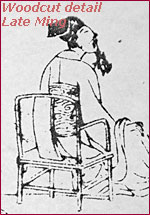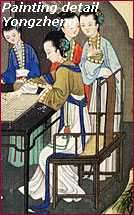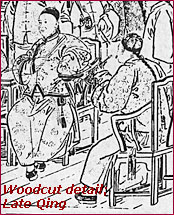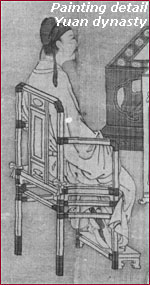 The ‘southern official' armchair’ (nanguan mao yi) is characterized by armrests and crestrail that turn down into the vertical posts. Chinese craftsman term this right angle joint a ‘pipe joint’, which reflects a resemblance to a smoking pipe. The employment results in a smooth, fluid impression.
The ‘southern official' armchair’ (nanguan mao yi) is characterized by armrests and crestrail that turn down into the vertical posts. Chinese craftsman term this right angle joint a ‘pipe joint’, which reflects a resemblance to a smoking pipe. The employment results in a smooth, fluid impression.
The name ‘southern official' armchair’, too, does not appear in early texts, but nevertheless, is antithetical to the protruding-end ‘official’s hat’ chair that is more commonly found throughout northern China.

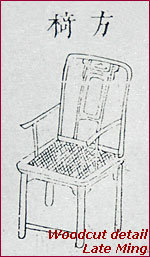 Early evidence of the style appears in paintings from the Song and Yuan periods. The late Ming period encyclopedia, Sancai tuhui (pub. 1607) depicts a variation in which the armrests protrude along with the more simplified term, ‘square [back] chair’ (fangyi), which is also a direct opposite to the ‘round [back] chair’ noted below. These illustrations also clearly demonstrate the early use of framed back splats, which were typically fit with small panels of figured wood or stone, carved decoration or painted imagery.
Early evidence of the style appears in paintings from the Song and Yuan periods. The late Ming period encyclopedia, Sancai tuhui (pub. 1607) depicts a variation in which the armrests protrude along with the more simplified term, ‘square [back] chair’ (fangyi), which is also a direct opposite to the ‘round [back] chair’ noted below. These illustrations also clearly demonstrate the early use of framed back splats, which were typically fit with small panels of figured wood or stone, carved decoration or painted imagery.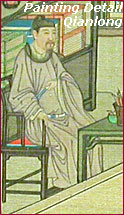 Southern official chairs are generally classified as highback or lowback chairs, the overall height of the latter usually less than 100 cm. Highback chairs tend to be most comfortable; according to Gao Lian, the comfort of headrest should be a primary factor in the selection of a chair.
Southern official chairs are generally classified as highback or lowback chairs, the overall height of the latter usually less than 100 cm. Highback chairs tend to be most comfortable; according to Gao Lian, the comfort of headrest should be a primary factor in the selection of a chair. 